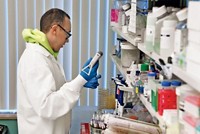Advertisement
Grab your lab coat. Let's get started
Welcome!
Welcome!
Create an account below to get 6 C&EN articles per month, receive newsletters and more - all free.
It seems this is your first time logging in online. Please enter the following information to continue.
As an ACS member you automatically get access to this site. All we need is few more details to create your reading experience.
Not you? Sign in with a different account.
Not you? Sign in with a different account.
ERROR 1
ERROR 1
ERROR 2
ERROR 2
ERROR 2
ERROR 2
ERROR 2
Password and Confirm password must match.
If you have an ACS member number, please enter it here so we can link this account to your membership. (optional)
ERROR 2
ACS values your privacy. By submitting your information, you are gaining access to C&EN and subscribing to our weekly newsletter. We use the information you provide to make your reading experience better, and we will never sell your data to third party members.
Pharmaceuticals
Pandemic Readiness
Drug and vaccine makers prepare for a more virulent strain of H1N1
by Lisa M. Jarvis
May 11, 2009
| A version of this story appeared in
Volume 87, Issue 19

FIVE WEEKS into the worldwide swine flu crisis, U.S. health authorities say the H1N1 virus is weaker than originally thought. But fearing that the virus could return with a vengeance, officials are coordinating with drug and vaccine makers to prepare for a pandemic.
"The good news is this virus does not seem to be as severe as we once thought it could be, based on the very early studies in Mexico," Secretary of Health & Human Services Kathleen Sebelius said last week. Still, she added, no one knows the course the virus will take come fall, the traditional flu season.
As such, HHS has initiated the first steps in making an H1N1 vaccine. It has identified the virus strain and is now developing a seed strain to distribute to manufacturers. Drug companies such as Sanofi-Aventis, GlaxoSmithKline, and MedImmune say they are standing by to begin production of a vaccine against H1N1 as soon as they receive the starting materials.
It takes up to six months to go from seed strain to vaccine doses, leaving health officials with a quandary: Should they divert manufacturing capacity now devoted to producing seasonal flu vaccine to make a vaccine tailored to H1N1?
Some companies believe available capacity could be sufficient for both. Just last week, Sanofi received FDA approval to manufacture seasonal flu vaccine at a new facility in Swiftwater, Pa. The plant triples the company's capacity at the site to 150 million doses annually.
In 2007, HHS awarded Sanofi a $77.4 million contract to retrofit that site for preparedness for a flu pandemic. One strategy to meet the need for both seasonal flu and H1N1 vaccines would be to produce the seasonal flu vaccine at the existing Swiftwater facility and the H1N1 vaccine at the new site, a Sanofi official says.
Meanwhile, Roche and GSK, which make antiviral drugs to treat the flu, are both ramping up manufacturing. GSK has a stock of 6 million packs of Relenza and will in the next three months be able to make 5 million packs per month.



Join the conversation
Contact the reporter
Submit a Letter to the Editor for publication
Engage with us on Twitter